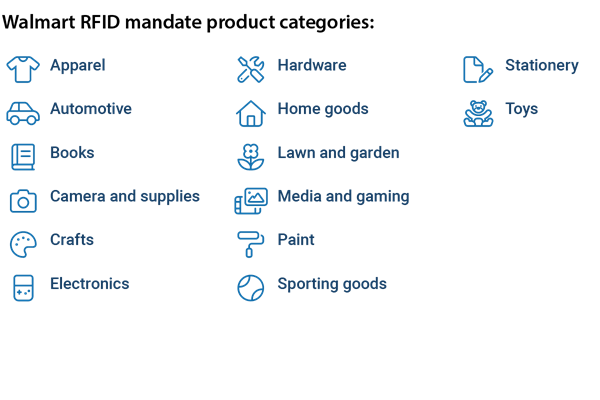
What is the Walmart mandate?
Walmart has long been a leader in the retail industry’s use of RFID, and in recent years, its embrace of the technology has expanded beyond its own use. In 2020, the retail giant began requiring its apparel suppliers to add RFID tags to items so products could be tracked as they were received, distributed, and sold in stores — citing major improvements in inventory accuracy, shopper experience, and omnichannel capabilities. In 2022 and again in 2023, Walmart expanded its RFID mandate to additional product categories, requiring many more suppliers to apply item-level RAIN RFID tags on select products sent to Walmart’s distribution centers.
Walmart’s broadened mandate now includes products in a variety of product categories, as outlined in the Walmart Resource Guide.
.png?width=600&height=400&ext=.png)
Getting started: Meet the mandate with Impinj
If you're a supplier that’s new to RAIN RFID, or even someone who has used RFID in the past, complying with Walmart’s RFID tagging requirements can be a challenge.
Download a copy of the new step-by-step guide from Impinj and Barcoding, “Guide to Walmart’s RFID Mandate: Five Steps to Compliance,” to learn more about how Impinj can help you meet the compliance requirements.
Read the guide to learn:
- The 5 steps to RAIN RFID adoption
- How to maximize your return on investment with RFID
- Where to find the help you need to get started
More than a mandate — it's an opportunity
RAIN RFID adds value for suppliers across their enterprises
Gain real-time item visibility throughout the supply chain
When each item is affixed with a RAIN RFID tag, it can be identified and tracked as it moves from manufacturing to distribution to a store’s shelf — in real time.
Optimize labor and allocate resources more efficiently
RAIN RFID automates repetitive and time-consuming tasks, cutting down on human error and freeing up employees to focus on more rewarding, higher-value activities.
Drive efficiencies that reduce environmental impacts
With the granular-level, real-time inventory insights that RAIN RFID provides, suppliers can reduce excess inventory and cut back on waste.
Streamline shipping and receiving processes
RAIN RFID-tagged items are read automatically as items enter or leave a facility, reducing the amount of time spent on data entry and paperwork.
Fine-tune delivery routes and track shipments more accurately
By reducing unnecessary transportation and minimizing fuel consumption, suppliers can lower their carbon emissions and contribute to a more sustainable logistics network.
Protect brands from counterfeiting
Brand protection solutions built by Impinj partners automatically authenticate items as they travel through various points in the supply chain, helping companies protect their brands and build customer trust.

Impinj is here to help
Impinj RAIN RFID experts are here to help you define, design, and deploy a RAIN RFID tagging program that not only meets Walmart’s requirements, but also streamlines your operations and unlocks powerful insights.
Reach out to an Impinj RFID expert to:
- Understand your product tagging needs
- Achieve the greatest RFID ROI
- Understand the basics of RAIN RFID technology
- Connect you with experts in the Impinj Partner Network to build your RFID tagging and reading strategies
Frequently Asked Questions
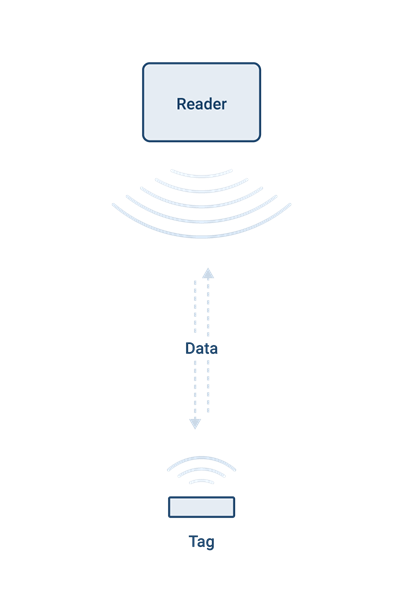 Radio Frequency Identification (RFID) is a form of wireless communication that uses radio waves to identify and find objects. RFID is a generic term that encompasses different frequencies and standards, including both NFC and RAIN — two technologies supported by industry alliances. In simple terms, all RFID systems operate on the same principle: An RFID tag stores information that can be read wirelessly by an RFID reader.
Radio Frequency Identification (RFID) is a form of wireless communication that uses radio waves to identify and find objects. RFID is a generic term that encompasses different frequencies and standards, including both NFC and RAIN — two technologies supported by industry alliances. In simple terms, all RFID systems operate on the same principle: An RFID tag stores information that can be read wirelessly by an RFID reader.
.png?width=400&height=600&ext=.png) RAIN RFID is a passive, battery-free wireless technology that allows retailers to track and locate every tagged item quickly and accurately, bringing powerful insights and real-time visibility to inventory and operations with near-100% accuracy. RAIN can identify up to 1,000 items per second, does not require line-of-sight to read tagged items, and can read tags at close range or from a distance. It is the fastest growing segment of the RFID market and uses a single, global standard: UHF Gen 2 (ISO/IEC 18000-63).
RAIN RFID is a passive, battery-free wireless technology that allows retailers to track and locate every tagged item quickly and accurately, bringing powerful insights and real-time visibility to inventory and operations with near-100% accuracy. RAIN can identify up to 1,000 items per second, does not require line-of-sight to read tagged items, and can read tags at close range or from a distance. It is the fastest growing segment of the RFID market and uses a single, global standard: UHF Gen 2 (ISO/IEC 18000-63).
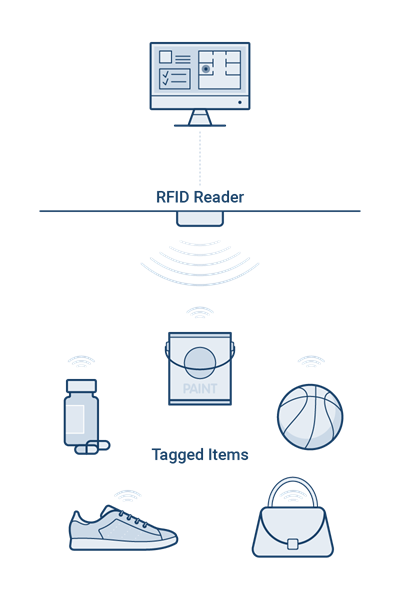 In RAIN RFID systems, the reader and reader antenna send a radio signal to the tag, which consists of a battery-free tag chip and an antenna. The RFID tag then uses the transmitted signal to power on and reflect energy back to the reader. The reader then reads the information encoded to the tag and stores it either locally or in a cloud-based application.
In RAIN RFID systems, the reader and reader antenna send a radio signal to the tag, which consists of a battery-free tag chip and an antenna. The RFID tag then uses the transmitted signal to power on and reflect energy back to the reader. The reader then reads the information encoded to the tag and stores it either locally or in a cloud-based application.
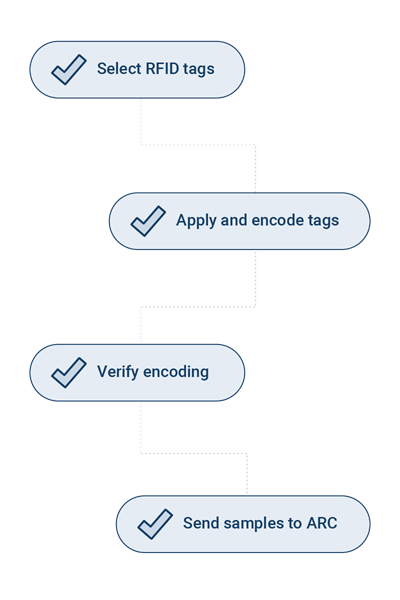 Select the appropriate RFID tags for your products, apply and encode tags at a point within your operations, verify that they are correctly encoded, and send samples to the Auburn RFID Center (ARC) for approval. The Auburn University Submission Guide provides instructions for preparing samples. For help navigating this process, connect with Impinj.
Select the appropriate RFID tags for your products, apply and encode tags at a point within your operations, verify that they are correctly encoded, and send samples to the Auburn RFID Center (ARC) for approval. The Auburn University Submission Guide provides instructions for preparing samples. For help navigating this process, connect with Impinj.
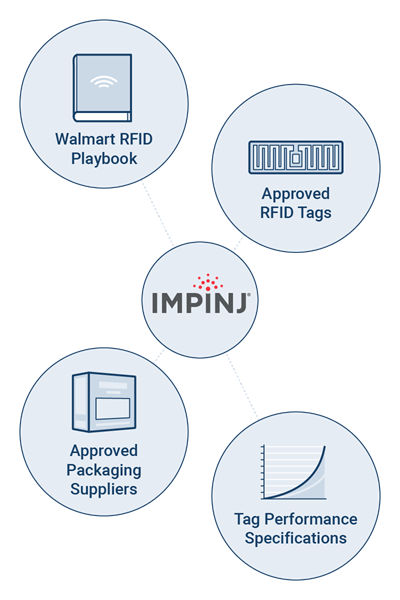 Walmart has helped streamline the tag selection process by providing RFID playbooks, a list of approved RFID tag and packaging suppliers, and tag performance specifications via the Auburn RFID Center (ARC). The RAIN experts at Impinj can help you determine which tags are the best fit for you.
Walmart has helped streamline the tag selection process by providing RFID playbooks, a list of approved RFID tag and packaging suppliers, and tag performance specifications via the Auburn RFID Center (ARC). The RAIN experts at Impinj can help you determine which tags are the best fit for you.

Report: Why 97% of supply chain professionals are turning to RFID
Supply chain professionals are concerned about labor shortages, managing inventory, and meeting sustainability goals. With RAIN RFID, organizations can gain end-to-end visibility that boosts efficiency and bolsters resiliency. Get your complimentary copy of the Impinj and Supply Chain Dive report, “Inventory, Labor and Sustainability: How RFID Solves Today’s Supply Chain Challenges” to learn why 97% of supply chain professionals are turning to RAIN RFID.
Download Report
Learn more about RAIN RFID

All in on RAIN RFID, Walmart Lights the Way for Retail
Walmart’s RAIN RFID tagging program, expanding to an increasing list of merchandise categories, will have a ripple effect on digital transformation and retail strategies worldwide.
Learn More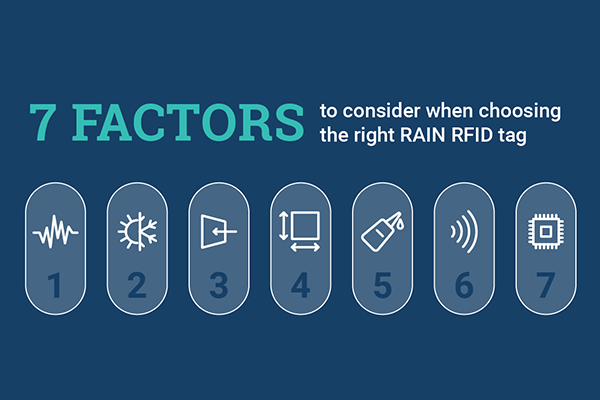
What to Consider When Choosing a RAIN RFID Tag
RAIN RFID tags come in a variety of sizes and shapes to meet the needs of all kinds of applications. Here’s how to select the right tag for your deployment.
Learn More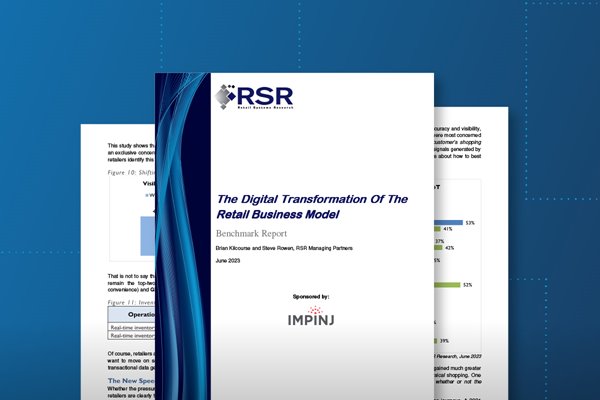
Why RAIN RFID is the Linchpin for Retail Digital Transformation
The 2023 benchmark report from Retail Systems Research explains why RFID is the foundation on which retailers must build their future — to be competitive and to survive.
Learn More